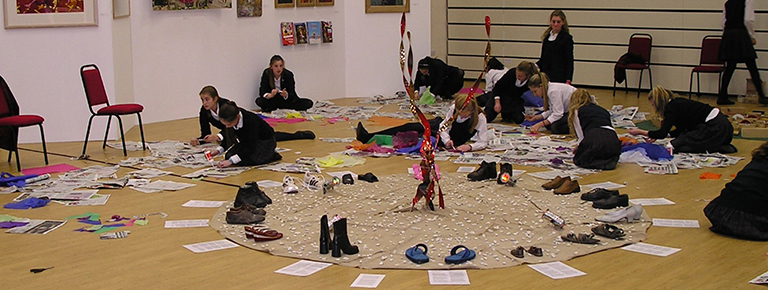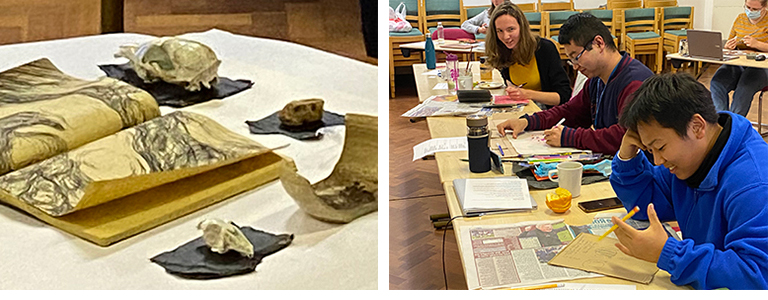Workshop Examples


‘A’ Level or GCSE Student Workshop
These workshops stimulate pupils to explore their own artistic ideas without the constraints of the curriculum, encourage lateral thinking, and work towards a 2D or 3D piece that expresses a topical and personal idea. Typically a broad and open-ended theme is chosen for the workshop - such as stereotyping, compassion, utopia, old age or the beatitudes - within which pupils can find a personal angle that matters to them.
The session starts with a slide show and discussion of the artist’s own work for students to consider the variety of language, symbols and media used to convey meaning. This is followed by a brainstorming session to generate ideas, look at alternatives, and choose available materials best suited to carry out the concept.
The main body of time is for each pupil to explore their ideas and develop their projects as painting, sculpture or temporary installation, with the artist encouraging and challenging them along the way. Reference to newspaper stories and other cultural references is encouraged, as is the use of photography and digital material where printing is easily accessible. Paul Hobbs’ own artwork involves a certain amount of collaging, so it is possible that students will want to explore this option by including newspaper imagery in their artwork.
Usually these workshops last 1-3 days, to enable sufficient progress. Their greatest value for students is in learning to think deeply about symbolic expression and conveying meaning - in being stretched mentally rather than learning a particular technical skill. The workshop closes with a ‘show and tell’ session at which students show their work, explain their ideas, and outline what they still intend to do. It is common that some pieces will need extra time for completion as all students are working differently with varying objectives.
A Sixth Former writes:
- ‘Paul talked to each of us individually, making us question our thoughts and consider the most appropriate way of trying to visualise them. We were encouraged to use a wide variety of materials, to develop a symbolic language to express the issue we had chosen to represent. It was hard work, mentally and physically - but a great challenge.’
Primary School Abstract Workshop
In this workshop, pupils make pictures to reflect mood and feeling using line, colour and pattern, with reference to different shapes and surfaces from their environment, e.g. sports equipment, books, toys or flowers.
Holy Ground Shoes Workshop
Taking inspiration from the Holy Ground installation, students interview members from the local church about their Christian faith, and then present this text alongside a display of the interviewees’ shoes, or an artwork about from their shoes. This is a great way to connect with the local community and to understand others’ belief in God.
Church Workshops
Similar to the Schools Workshops these sessions look to develop artworks around a theme, but with a more deliberate spiritual focus. Using paint and simple sculptural materials that can be easily sourced, the exercise is more to do with thinking laterally and expressing an important idea in an engaging way, while reflecting God’s heart for particular issues. Themes might involve a response to articles in the newspapers, or a scriptural text, and lead to making art as prayer and reflection, as story telling and teaching, or as worship and celebration.
Like the Schools Workshops these begin with a slide show of the artist’s own work to stimulate ideas followed by a brainstorming session on the agreed theme, including perhaps a warm-up game of Pictionary to get people sketching ideas around the topic.
Each person then develops their own response to the theme, to make painting, simple sculptures or temporary installations, either individually or in pairs, with the artist available to encourage and support them. Materials offered usually include acrylic paint and simple sculptural materials such as cardboard, craft knives, wire, string, glue and withies. Digital cameras are handy if printing facilities are easily available.
At the end of the session, everyone is invited to talk about their work and the issue or concept they have explored. The chief benefit of the project is to experiment with materials and to prayerfully explore how to express an issue or story, rather than master a technique or make a finished product.
Comments:
- ‘It was fascinating listening to and working with Paul – a real delight. Time went so fast that I finished mine at home.’
- ‘I was amazed how every single one of us were inspired to the point of overcoming our reservations and just diving in to create something meaningful to each of us.’
- ‘Paul’s talk was so interesting and inspiring. I was in my element having a wonderfully messy, sticky time creating a response to his suggestions.’